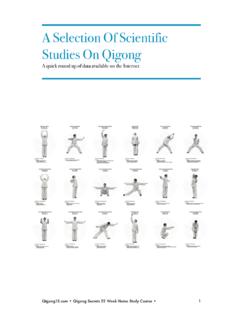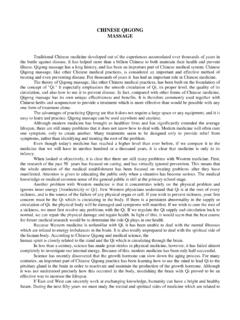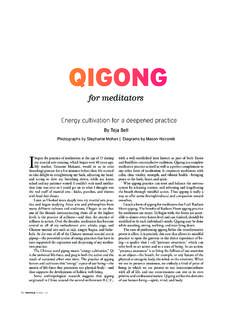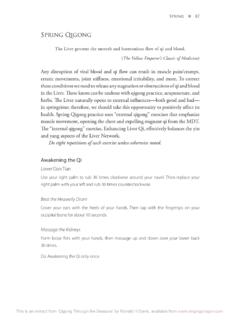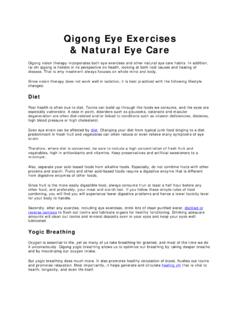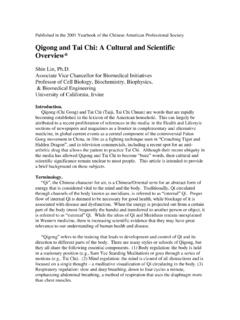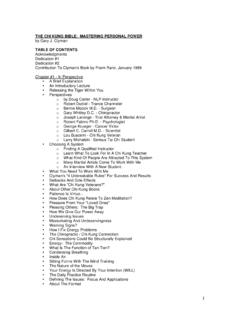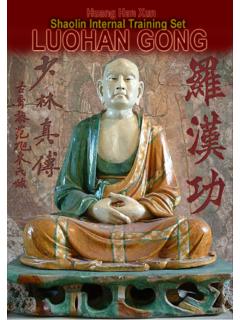Transcription of Shaolin Nei Jing Yi Zhi Chan Standing Meditation Method
1 Shaolin Nei Jing Yi Zhi Chan Standing Meditation Method Shaolin Nei Jing Yi Zhi Chan , which means Internal essence no intent Zen and emitting your inner chi energy through one s ten fingers is an advanced qigong from the Buddhist tradition. Chan means Zen in Chinese and refers to the No Thinking style of this Standing Meditation practice known as Zhuang Zhuang (Jan Jong). The exercise methods are simple and produce truly marvelous effects. Due to the Chan (Zen) nature of the Method , it is not required to concentrate your attention while practicing. You can even watch TV while performing this system of qigong . Through this training, all of the body s energy channels will be automatically cleared and opened from the Zhuang Zhuang exercises. This will allow you to accumulate outer chi or universal life force and also emit your own chi.
2 These exercises will dramatically improve your health which can cause the effect of having diseases spontaneously enter remission. By continued practice and skill, you will be able to emit your Chi into others to examine and aid in their healing of illness or diseases. Reaching a Master s level will fully awaken the Greater Kan & Li (Fire & Water) also known as Kundalini energy allowing you to explore your dormant primordial energy with all of its various paranormal or mystical capabilities. This energy is also known as Spirit , The Advocate . The Key to Knowledge , The Holy Spirit , The Dragon or Serpent , The Mustard Seed , The Breath of God , Lightning or Lightning Bolt , etc. in various religions and traditions. Awakening this dormant energy is doorway to enlightenment and finding God, the divine or universe within you.
3 Shaolin Nei Jing Yi Zhi Chan originated from the Shaolin Monastery under the strong influence of Chinese martial arts Wu Shu and internal body exercises Shaolin Nei Gong. While most Buddhist meditations methods have their emphasis on mind cultivation this particular Method focuses on the body cultivation instead as a result of the martial arts influence. In many respects, it is really a hybrid combination that most likely was the result of the arrival of the sage Bodhidharma at the monastery. Shaolin One Finger qigong 's intention is to build your body's chi on 10 levels. Unlike most styles of qigong , this style requires the student to NOT think about or guide chi but rather to generate chi and allow it to flow naturally. The emphasis is that chi is smart in itself and understands the natural flow in the channels.
4 In Chinese Medicine disease or pain derives from chi deficiency and stuck or blocked chi in the body. So as the student fills up with chi, the chi flows it's natural pattern and timing. In today's fast paced lifestyles we use our minds way too much. This training is an opportunity to move away from that cycle. The basic motto of this qigong is RELAX, KEEP DOWN, AND NO THINKING. The Standing practice is based on the postures of Arhats, which are somewhat like saints or perfected men. There are 500 postures based on this Method but only a few are needed to achieve desired results. Many people falsely believe that no-mind or intent means complete mental silence, which can and does occur at times, but the real objective is to simply stay in the present moment not allowing your mind to drift off into memories of the past or projections into the future.
5 Keep your awareness in the Here and Now and the rest will automatically take care of itself. You can watch TV; listen to music and even talk with others while practicing so it is not like a deep state of Meditation . It also means that you are not allowed to intentionally guide the chi through the body s channels. When you feel the chi, just let it do what it is going to do naturally. Begin this practice by acquiring the ability to hold the main posture for 20-minutes or more. Begin with maybe a stand of 5-minutes and then add a one minute each day until you reach a 20-minute practice. It is best to practice Zhang Zhuang 1to 2 hours after eating. Also, when you finish, drink a glass of warm water (room temperature is fine) and do not shower or bathe for at least 1-hour. Fundamental Arhat Posture of Shaolin Nei Jing Yi Chan qigong .
6 Preparing posture: Relax completely in Wu Ji #1. Stand with feet shoulder-width apart. Point the toes straight forward but also slightly inward. Your arms hanging naturally with palms touching the thighs. Keep the head and neck erect with eyes looking straight ahead. Just breathe naturally. Wu Ji Posture Standing posture: Squat down a little allowing the knees to come inwards toward one another. Then flex both knees outward like riding a horse. This adds torque to the tendon lines of the legs (This stance should also be used in your Yijin Ching practice). Meanwhile, slowly raise and stretch forth your upper arms slowly, and have the armpits opened (with enough space to hold an egg in it). Slowly raise forearms, which should be parallel to each other, to the ground-paralleling level with palms facing downward and fingers straightening naturally.
7 Keep the backs of the hands and the forearms at the same height (See photo above & Fig. 2). Main Points Stand with soles in full contact with ground surface and with toes gently grasping the ground. (Refer to Fig. 3) Point knees to insteps, but do not exceed the perpendicular of the toes. Shrink & gently contract anus, withdraw hip and draw in the abdomen a little. Relax the torso completely with shoulders and elbows, twisting free without stiffening. Keep lower limbs Standing freely. Relax thighs and calves and erect your torso by raising your core upwards. Curve the chest a bit inward and, imagine as if you were uplifting your tailbone. Look straight ahead with regular qigong breathing. Inhale through the nose and exhale through the mouth. 1st hold up all fingers naturally.
8 Do not put forth any strength nor stiffen. Hold up thumb naturally beside forefinger. Keep forefinger in line with the back of the hand. Lower the positions of forefinger, middle finger, ring finger and little finger naturally and sequentially, shaped like staircase. If you imagine that you are trying to hold a small bowl in each hand by palming it as gently as possible, you will have the correct hand position. If you fully open and stretch your hand and fingers out as far as possible and then just let the entire hand relax it will naturally achieve the correct hand position. To correctly practice this Method , begin by Standing in the void (Wu Ji) for a few minutes to relax and calm the mind. Count backwards (10, 9, 8, 7, 6, 5, 4, 3, 2, 1) a few times to help quiet the mind.
9 Perform 3 repetitions of propping up the sky from the Eight Brocade. After the 3rd repetition relax your arms back into Wu Ji and then squat down a little deeper and move into the fundamental Arhat posture just illustrated and discussed above by slowly raising your forearms upwards and elbows slightly forward and out away from your body. The goal is to eventually hold this posture for 20-minutes and then continue with the Finger bending exercises before ending the practice. After finishing the finger prescribed finger bends, relax with your hands covering the dan tien (3 inches below your navel) to allow the energy to settle. Finish by walking around for several minutes to relax the legs and circulate the accumulated chi and blood flow. In the early stages of Zhang Zhuang training, you may shake or vibrate uncontrollably, sweat intensely, feel itchy or tingly, various sensations of heat or cold, your feet may bother you, your muscles may feel sore, especially the thighs, calves and shoulders.
10 You may experience numbness or some type of asymmetry in terms of physical balance or even asymmetry of the sensations described. For example, one side of your body could feel warm and the other side could feel cold. However, with continued practice, usually by the 6th week, this will become a very pleasant exercise that you will look forward to doing each day. Persevere it is well worth the effort. As your chi gets stronger, the exercise becomes pleasant and effortless. The author has personally stood in the fundamental Arhat for 3 hours straight in a state of pure bliss. Every internal style of martial arts that focuses on chi development and internal strength utilizes Zhang Zhuang as the primary chi building exercise. This is truly a remarkable Method of qigong training with a history going back 1000 s of years.
